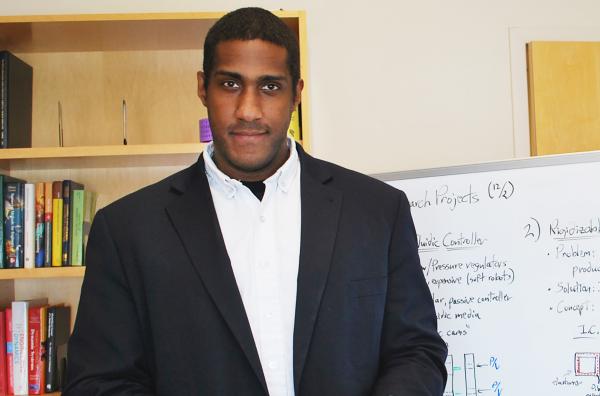When COVID-19 causes acute respiratory distress syndrome (ARDS), damaging lung tissue, the affected areas are unable to efficiently uptake blood oxygen, which leads to diminished of lung function. One of the ways clinicians try to treat this problem is with proning, or prone positioning, in which patients are placed on their stomach, using gravity to help redistribute the blood flow away from damaged areas to reach healthy regions of the lung – increasing oxygen uptake.
Frank Hammond, assistant professor in the Wallace H. Coulter Department of Biomedical Engineering at the Georgia Institute of Technology and Emory University, has come up with a solution that you can wear – a vest that may change how clinicians treat at-risk patients with ARDS, which can also be caused by pneumonia, sepsis, the inhalation of harmful substances, or other injuries.
Proning requires labor-intensive physical tasks, so it can be risky for some patients. “It may have an adverse reaction, such as a cardiac event, during this kind of physical repositioning,” notes Hammond, who has a joint appointment in the George W. Woodruff School of Mechanical Engineering, partnered with Emory physician Maxwell Weinmann to address the problem.
Weinmann had some success manipulating fluids in patients’ lungs by placing weight (in the form of bags of water) on their bodies to supply pressure and modify blood flow in the lungs. Hammond suggested that a vest with custom bladders could be filled with air, pressing against the patient and moving fluid in the lungs to simulate proning without moving the at-risk patient.
The result is a soft pneumatic ventilation-perfusion vest designed to redistribute of blood to uninflamed, oxygen-rich areas of the lungs, increasing ventilation and, ideally, improving patient outcomes.
“We are manipulating pulmonary blood flow with this vest,” Hammond says. “We completed a functional prototype and Dr. Weinmann is working toward a clinical trial, to learn about the long-term impacts of ‘simulated proning’. Based on preliminary results, we will pursue NIH and other sources of funding to further develop these important devices and facilitate mass-production using economical manufacturing methods.”
Hammond intends to develop a disposable, affordable, efficient device that will cost under $50, a new tool for an emerging new era in health care in the pandemic age. This project received a boost of $17,000 through the COVID Rapid Response Seed Grant program, launched by the Georgia Tech Office of the Executive Vice President for Research (EVPR).
Recently, the EVPR’s office announced more than 20 projects that received seed funding through the program, including several involving Coulter Department faculty. In addition to Hammond, Phil Santangelo (professor of BME) and Ed Botchwey (associate professor) are leading projects that received EVPR seed funding.
Media Contact
Jerry Grillo
Writer/Communications Officer
Georgia Institute of Technology
Keywords
Latest BME News
Jo honored for his impact on science and mentorship
The department rises to the top in biomedical engineering programs for undergraduate education.
Commercialization program in Coulter BME announces project teams who will receive support to get their research to market.
Courses in the Wallace H. Coulter Department of Biomedical Engineering are being reformatted to incorporate AI and machine learning so students are prepared for a data-driven biotech sector.
Influenced by her mother's journey in engineering, Sriya Surapaneni hopes to inspire other young women in the field.
Coulter BME Professor Earns Tenure, Eyes Future of Innovation in Health and Medicine
The grant will fund the development of cutting-edge technology that could detect colorectal cancer through a simple breath test
The surgical support device landed Coulter BME its 4th consecutive win for the College of Engineering competition.









